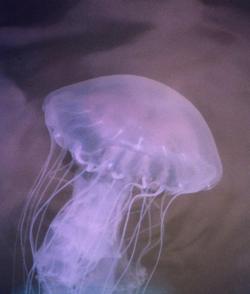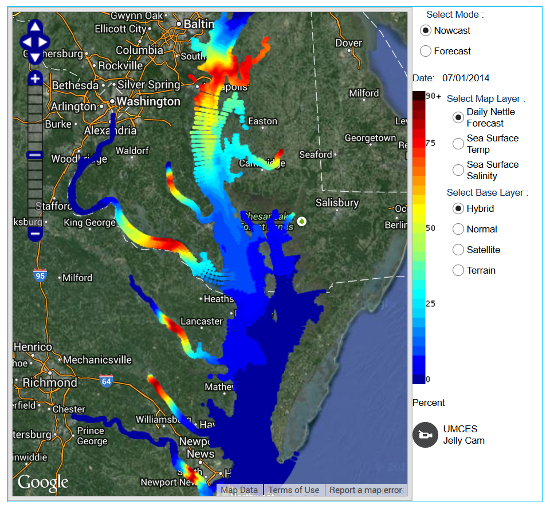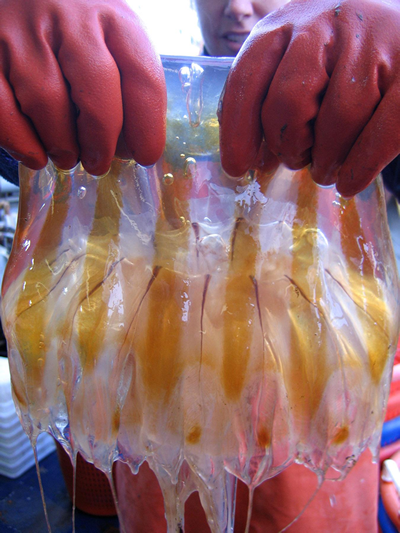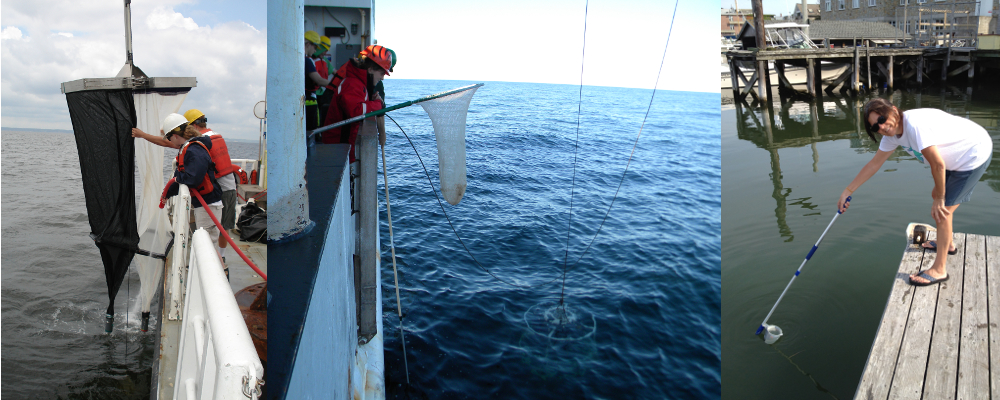Research
Many of the world’s largest fisheries target planktivorous forage fish, which are important trophic links between plankton and upper-level consumers, such as fish, birds and mammals. Because plankton also drive jellyfish production, forage fish and jellyfish tend to overlap in space, time and diet. This overlap can lead to predatory and competitive interactions, because jellyfish feed on early-life stages of fish and zooplankton. Furthermore, the harvest of forage fish potentially releases jellyfish from competition and is hypothesized to increase jellyfish production. To understand the roles of forage fish and jellyfish, we are using ecosystem models to explore how functional group productivity is altered in various coastal ecosystems under high jellyfish and low fish harvest scenarios. We propose that ecosystem-based management of forage fish stocks include jellyfish as an independent, empirical ‘ecosystem health’ indicator.
Collaborators: Ric Brodeur (NOAA/NWFSC), Monty Graham (USM), Kelly Robinson (OSU), Jim Ruzicka (OSU/NOAA) Sponsor: Lenfest Ocean Program
 Jellyfish blooms influence plankton dynamics in coastal waters worldwide and can negatively impact tourism in the coastal eastern U.S.A., yet factors that affect bloom development and distribution are not well understood. We used the stinging sea nettle, Chrysaora quinquecirrha, as a model system to examine physical factors that control jellyfish populations in Chesapeake Bay. Chrysaora has the potential to control the flow of energy and nutrients through the food web due to its seasonally high abundance and its extremely high consumption rates. The impact of sea nettles on the Chesapeake ecosystem and economy might be better understood if their presence could be predicted. We developed a model that describes the preferred habitat of the medusan form of Chrysaora. This empirically-derived model predicts the probability of Chrysaora encounter as a function of sea-surface temperature and salinity. Our habitat model is applied to near-real time estimates of temperature and salinity derived from hydrodynamic models. This method allows “nowcasts” to be generated for the distribution and likelihood of Chrysaora occurrence in Chesapeake Bay by identifying locations where ambient conditions coincide with Chrysaora’s preferred habitat. Current predictions of our habitat model can be viewed here.
Jellyfish blooms influence plankton dynamics in coastal waters worldwide and can negatively impact tourism in the coastal eastern U.S.A., yet factors that affect bloom development and distribution are not well understood. We used the stinging sea nettle, Chrysaora quinquecirrha, as a model system to examine physical factors that control jellyfish populations in Chesapeake Bay. Chrysaora has the potential to control the flow of energy and nutrients through the food web due to its seasonally high abundance and its extremely high consumption rates. The impact of sea nettles on the Chesapeake ecosystem and economy might be better understood if their presence could be predicted. We developed a model that describes the preferred habitat of the medusan form of Chrysaora. This empirically-derived model predicts the probability of Chrysaora encounter as a function of sea-surface temperature and salinity. Our habitat model is applied to near-real time estimates of temperature and salinity derived from hydrodynamic models. This method allows “nowcasts” to be generated for the distribution and likelihood of Chrysaora occurrence in Chesapeake Bay by identifying locations where ambient conditions coincide with Chrysaora’s preferred habitat. Current predictions of our habitat model can be viewed here.
Collaborators: Christopher Brown (NOAA/NESDIS/ORA), Raleigh Hood (UMCES Horn Point Laboratory) and Jennifer Purcell (Shannon Point Marine Center)
Sponsor: NOAA’s National Centers for Coastal Ocean Science EcoForecasting Program

 For many organisms, the reconstruction of source-sink dynamics is hampered by limited knowledge of the spatial assemblage of either the source or sink components or lack of information on the strength of the linkage for any source-sink pair. In the case of marine species with a pelagic dispersal phase, these problems may be mitigated through the use of particle drift simulations based on an ocean circulation model. However, when simulated particle trajectories do not intersect sampling sites, the corroboration of model drift simulations with field data is hampered. We apply a new statistical approach for reconstructing source-sink dynamics that overcomes the aforementioned problems. This research is motivated by the need for understanding observed changes in jellyfish distributions in the eastern Bering Sea since 1990. By contrasting the source-sink dynamics reconstructed with data from the pre-1990 period with that from the post-1990 period, it appears that changes in jellyfish distribution resulted from the combined effects of higher jellyfish productivity and longer dispersal of jellyfish resulting from a shift in the ocean circulation starting in 1991.
For many organisms, the reconstruction of source-sink dynamics is hampered by limited knowledge of the spatial assemblage of either the source or sink components or lack of information on the strength of the linkage for any source-sink pair. In the case of marine species with a pelagic dispersal phase, these problems may be mitigated through the use of particle drift simulations based on an ocean circulation model. However, when simulated particle trajectories do not intersect sampling sites, the corroboration of model drift simulations with field data is hampered. We apply a new statistical approach for reconstructing source-sink dynamics that overcomes the aforementioned problems. This research is motivated by the need for understanding observed changes in jellyfish distributions in the eastern Bering Sea since 1990. By contrasting the source-sink dynamics reconstructed with data from the pre-1990 period with that from the post-1990 period, it appears that changes in jellyfish distribution resulted from the combined effects of higher jellyfish productivity and longer dispersal of jellyfish resulting from a shift in the ocean circulation starting in 1991.
Collaborators: Kung-Sik Chan (U Iowa), Lorenzo Ciannelli (OSU), Carol Ladd (NOAA/PMEL), Wei Cheng (NOAA/UW-JISAO)
Sponsor: NSF Collaboration in Mathematical Geosciences
 Large scyphozoan jellyfish feed on zooplankton and early life stages of fish; they are potentially important competitors and predators of fish. Eastern Bering Sea (EBS) fishery surveys indicate that jellyfish populations can grow dramatically and have fluctuated widely over the last 3 decades. These changes have been related to variability in climate and prey resources. An understanding of the role of jellyfish in the EBS is required for fishery and ecosystem management, however, we lack measurements of the direct and indirect impact of changes in jellyfish abundance on the ecosystem and the fish species it supports. The goals of this research are to estimate the scale and impact of competition between forage fish, and jellyfish in the EBS and to examine the role of jellyfish in the ecosystem as a predator and as an ecosystem structuring agent. To achieve these goals, we will quantify the predation potential of jellyfish upon zooplankton and the early life-history stages of fish, determine dietary and spatial overlap of jellyfish and forage fish, examine interannual relationships between fish production and indices of jellyfish biomass, examine the impact of jellyfish variability across all groups in the food web via ecosystem models, and compare the role of jellyfish in the EBS ecosystem with their role in other coastal ecosystems by coordinating with sister studies.
Large scyphozoan jellyfish feed on zooplankton and early life stages of fish; they are potentially important competitors and predators of fish. Eastern Bering Sea (EBS) fishery surveys indicate that jellyfish populations can grow dramatically and have fluctuated widely over the last 3 decades. These changes have been related to variability in climate and prey resources. An understanding of the role of jellyfish in the EBS is required for fishery and ecosystem management, however, we lack measurements of the direct and indirect impact of changes in jellyfish abundance on the ecosystem and the fish species it supports. The goals of this research are to estimate the scale and impact of competition between forage fish, and jellyfish in the EBS and to examine the role of jellyfish in the ecosystem as a predator and as an ecosystem structuring agent. To achieve these goals, we will quantify the predation potential of jellyfish upon zooplankton and the early life-history stages of fish, determine dietary and spatial overlap of jellyfish and forage fish, examine interannual relationships between fish production and indices of jellyfish biomass, examine the impact of jellyfish variability across all groups in the food web via ecosystem models, and compare the role of jellyfish in the EBS ecosystem with their role in other coastal ecosystems by coordinating with sister studies.
Collaborators: Ric Brodeur (NOAA/NWFSC), Kristin Cieciel (NOAA/AFSC) and Jim Ruzicka (OSU/NOAA) Sponsor: North Pacific Research Board

